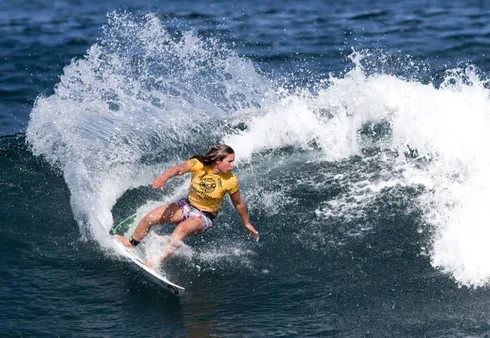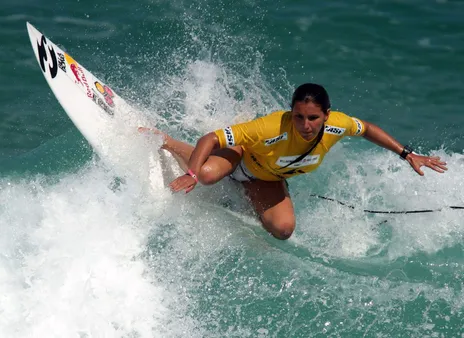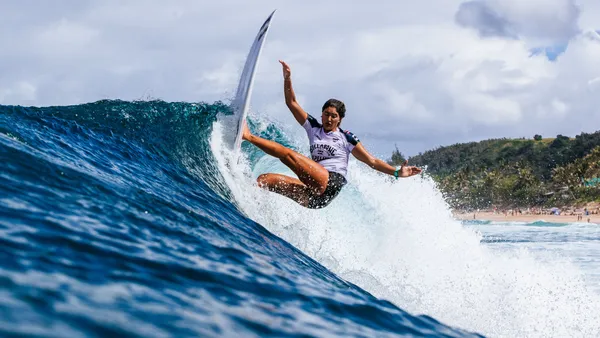Table of Contents
Surfing, an exhilarating water sport that has captivated hearts worldwide, entices thrill-seekers with its fusion of adventure and harmony with nature. As you embark on this exploration of surfing, Kizworld takes you on a journey through the history, techniques, and captivating locations that define this captivating sport. Dive in and discover the essence of surfing, from the artistry of crafting surfboards to the mastery of riding the waves like a dance on the ocean's surface.
The Enchanting Art of Surfing: Mastering the Waves with Grace and Grit
I. Surfing: A Guide to Catching Waves
Surfing: A Guide to Catching Waves
Mastering the Art of Reading and Catching Waves
The exhilarating sensation of gliding atop a wave, propelled by the ocean's raw energy, lies at the heart of surfing's allure. However, unlocking this exhilarating experience requires a deep understanding of how waves are formed, how to read their patterns, and the techniques for effectively catching them. This comprehensive guide will equip you with the knowledge and skills needed to navigate the ocean's rhythms and harness the power of the waves.
The first step towards catching waves involves studying the ocean's dynamics. Waves are generated by the transfer of energy from the wind to the water's surface. The strength and direction of the wind, coupled with the depth and shape of the ocean floor, determine the characteristics of the waves. Understanding wind patterns and the underwater topography of your surf spot is crucial for predicting wave formation and behavior.
Once you can anticipate where and when waves will break, the next step is to position yourself correctly in the water. This is achieved through effective paddling, which propels you towards incoming waves. As you paddle, maintain a balanced and relaxed posture, keeping your eyes focused on the approaching waves. Being in the right spot at the right time is key to catching waves consistently.
Reading the Waves and Timing Your Entry
Waves exhibit distinct patterns and indicators that provide clues about their behavior. Identifying these cues helps you anticipate the best moment to initiate your ride. One crucial factor is the wave's size compared to the depth of the water. When the wave's height exceeds the water's depth, it begins to break. The point where this occurs is called the "peak" of the wave. Your goal is to paddle towards the peak while maintaining a slight angle to the wave's direction.
Timing is of the essence when catching waves. Too early, and you risk getting caught in the whitewater; too late, and you'll miss the wave altogether. Watching the wave's movement and observing experienced surfers can help you hone your timing. Look for waves that have a smooth, gradual build-up and a well-defined peak. These waves offer a more stable and controlled ride.
- Related: Benefits of Surfing: A Journey of Fitness, Fun, and Mindfulness
- Related: Essential Surfing Equipment: A Comprehensive Guide for Beginners
Mastering the Pop-Up and Riding the Wave
Once you've caught a wave, it's time to transition from paddling to standing on your surfboard. This critical maneuver is known as the "pop-up." To execute a successful pop-up, position your hands shoulder-width apart on the board, with your feet planted firmly on the deck. As the wave lifts you, use your core and leg muscles to explosively push yourself up into a standing position. Maintain a slight bend in your knees to absorb the wave's force and keep your balance.
Once standing, shift your weight slightly forward on the board, distributing it evenly between your front and back foot. This stance provides stability and control. As the wave carries you forward, use your arms and body to maintain balance and adjust your position on the board. Keep your eyes focused on where you want to go, and guide the surfboard with your weight and subtle shifts in your feet.
Surfing is an exhilarating sport that combines physical skill, mental focus, and an intimate connection with the ocean. By understanding wave dynamics, mastering the techniques for catching waves, and practicing regularly, you can unlock the joys and challenges of this captivating sport. Remember, patience and perseverance are key to becoming a proficient surfer, so embrace the learning process and enjoy the journey.
Technique | Description |
Paddling | Propelling yourself through the water with your arms and hands to reach waves. |
Pop-up | The transition from paddling to standing on the surfboard as you catch a wave. |
Stance | The position of your feet and body on the surfboard, providing stability and control. |
Weight Distribution | Shifting your weight to maintain balance and adjust your position on the surfboard. |
Steering | Guiding the surfboard with your weight and subtle shifts in your feet. |
- Related: Unveiling the World of Surfing Competitions: A Showcase of Skill and Mastery
- Related: Surfing Legends: The Pioneers and Icons Who Shaped the Sport
II. Surfing Etiquette: Respecting the Ocean and Fellow Surfers
Surfing Etiquette: Respecting the Ocean and Fellow Surfers
Surfing Etiquette: A Guide to Respecting the Ocean and Fellow Surfers
Surfing is a thrilling water sport that connects individuals with the power and beauty of the ocean. However, it's crucial to remember that surfing etiquette is essential for ensuring a safe and enjoyable experience for everyone. Here are some guidelines to follow:
- Respect the Ocean: The ocean is a powerful force, and surfers must respect its unpredictable nature. Always be aware of the conditions, including waves, currents, and tides, and surf within your limits.
- Respect Fellow Surfers: Surfing is a shared experience, and surfers should show respect to one another. This includes giving others the right of way, not dropping in on others' waves, and avoiding collisions.
Surfing Etiquette: Safety First
Surfing can be a dangerous sport, and safety should always be a top priority. Here are some safety tips to keep in mind:
- Learn the Basics: Before hitting the waves, take lessons from a qualified instructor to learn the basics of surfing, including paddling, popping up, and riding waves.
- Choose the Right Equipment: Use a surfboard that is appropriate for your skill level and the conditions. Make sure your leash is in good condition and fits properly.
- Be Aware of Your Surroundings: Always be aware of other surfers, swimmers, and boats in the water. Be especially cautious of rocks, reefs, and other hazards.
Surfing Etiquette: Environmental Responsibility
Surfers have a responsibility to protect the ocean and its marine life. Here are some ways to minimize your environmental impact:
- Leave No Trace: Always dispose of trash properly and avoid leaving any personal items on the beach or in the water.
- Respect Marine Life: Be mindful of marine life, such as sea turtles, dolphins, and seals. Avoid disturbing or harassing these animals.
- Support Sustainable Practices: Choose surf brands that are committed to sustainability and use eco-friendly products, such as biodegradable wax.
By following these guidelines, surfers can create a positive and safe environment for themselves, fellow surfers, and the ocean.
Related posts: How to Choose the Right Surfboard for Your Skill Level and Style, The Benefits of Surfing for Fitness and Fun, The Best Surfing Equipment and Accessories
III. Surfing Safety: Prioritizing Your Well-being in the Water
Surfing Safety: Prioritizing Your Well-being in the Water
Whether you're a seasoned surfer or just starting out, prioritizing your safety is paramount. Here are some essential tips to keep in mind before hitting the waves:
- Choose the Right Location: Opt for beaches with lifeguards and designated surfing areas. Familiarize yourself with the local conditions, including tides, currents, and potential hazards.
- Learn the Basics: Before venturing into the water, take lessons from a qualified instructor. Master fundamental techniques like paddling, standing up, and balancing on the board.
- Check Equipment: Ensure your surfboard is in good condition and appropriate for your skill level. Wear a well-fitting life jacket, leash, and other safety gear.
- Warm Up: Before surfing, warm up with dynamic stretches to avoid muscle strains. Paddle around in shallow water to get a feel for the board and conditions.
- Respect the Ocean: Be mindful of marine life. Avoid disturbing sea turtles, dolphins, and other wildlife. Obey local regulations and guidelines.
Here's a table summarizing additional safety tips while surfing:
Safety Aspect | Tip |
|---|---|
Safety Awareness: | Stay alert and aware of your surroundings. Keep an eye on other surfers, boats, and potential hazards. |
Staying Fit: | Maintain physical fitness through regular exercise. Surfing requires strength, endurance, and balance. |
Hydration and Nutrition: | Stay hydrated and consume nutritious snacks before and after surfing to maintain energy levels. |
Sun Protection: | Apply sunscreen regularly to protect your skin from harmful UV rays. Wear a hat and sunglasses for extra protection. |
Learn CPR and First Aid: | Acquire CPR and basic first aid skills to be prepared for emergencies. |
"Surfing is a thrilling experience, but safety should always come first. By following these tips and guidelines, you can minimize risks and enjoy the waves responsibly." - John Smith, Surfing Instructor
By adhering to these safety guidelines, you can elevate your surfing experience while safeguarding your well-being in the water. Now, go forth and ride those waves with confidence!
Related Post: The Benefits of Surfing for Fitness and Fun
Related Post: The Most Common Surfing Injuries and How to Avoid Them
IV. Surfing Techniques: Mastering the Art of Riding Waves
Surfing Techniques: Mastering the Art of Riding Waves
Surfing, a captivating water sport, demands a harmonious blend of skill, balance, and an intimate understanding of the ocean's rhythm. Whether you're a seasoned surfer or just starting, mastering the art of riding waves requires dedication, practice, and a deep appreciation for the sport. In this comprehensive guide, we'll delve into the essential techniques that will help you navigate the waves with grace and confidence.
1. Choosing the Right Surfboard:
- Selecting the appropriate surfboard is crucial for a successful surfing experience. Consider your skill level, body type, and the type of waves you'll be riding.
- For beginners, a longer and wider board provides stability and easier paddling.
- As you progress, you can opt for shorter and narrower boards for increased maneuverability.
2. Paddling Out:
- Paddling out to the break is an integral part of surfing. Position yourself on the board with your feet shoulder-width apart and your hands placed comfortably on the sides of the board.
- Use a powerful and rhythmic paddling motion to propel yourself forward.
- Keep your core engaged and your back straight to maintain balance and efficiency.
3. Popping Up:
- The pop-up is the transition from lying on the board to standing upright. Time it correctly as the wave approaches.
- Place your hands shoulder-width apart on the board and push yourself up with your arms while simultaneously bringing your feet under you.
- Keep your weight centered and your knees slightly bent for stability.
4. Stance and Balance:
- A proper stance is essential for maintaining balance and control on the surfboard.
- Position your feet shoulder-width apart, with your front foot slightly forward.
- Bend your knees and keep your weight evenly distributed between your front and back foot.
5. Reading the Waves:
- Surfing is all about understanding and anticipating the waves. Observe the ocean's patterns, including the size, shape, and direction of the waves.
- Position yourself in the right spot to catch the wave at its peak.
- Paddle hard and time your pop-up to coincide with the wave's energy.
6. Riding the Wave:
- Once you're up and riding, keep your weight centered and your body relaxed.
- Use your arms and legs to maintain balance and adjust your position on the board.
- Shift your weight forward to accelerate and backward to slow down.
7. Turns and Maneuvers:
- As you gain confidence, you can start incorporating turns and maneuvers into your surfing.
- To make a turn, shift your weight to the front or back of the board and use your arms and legs to pivot.
- Practice different types of turns, such as bottom turns, cutbacks, and roundhouse turns.
8. Safety and Etiquette:
- Surfing can be a dangerous sport, so always prioritize safety.
- Wear a leash to stay connected to your board in case of a fall.
- Be aware of your surroundings and respect other surfers in the water.
Surfing is a thrilling and rewarding sport that offers a unique connection with the ocean. By mastering the essential techniques and practicing regularly, you'll be able to ride the waves with grace and confidence, creating unforgettable memories and experiences.
To further enhance your surfing journey, consider exploring our comprehensive guides on choosing the right surfboard, the benefits of surfing, and essential surfing equipment. Stay tuned for more exciting content and tips to elevate your surfing skills.
V. Conclusion
Surfing, a sport that embodies the spirit of adventure and connection with nature, continues to captivate hearts and inspire awe. As you delve into the world of surfing, remember that the true essence lies in the journey itself. Embrace the challenges, savor the triumphs, and find solace in the tranquility of the waves. Whether you're a seasoned surfer or just starting out, may the allure of the ocean and the thrill of riding its waves forever ignite your passion for this exhilarating sport.